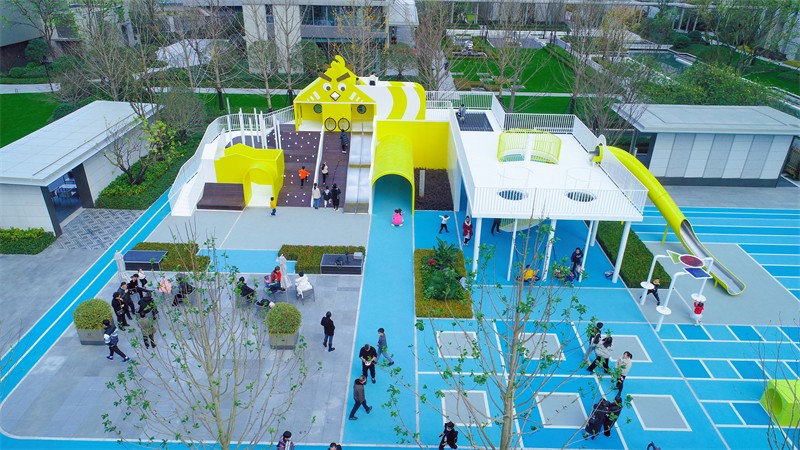When planning a children's playground, the choice of slide directly impacts children's safety and developmental experience. Children of different ages have significant differences in physical fitness, coordination, and psychological needs, making scientifically graded slide design crucial. The following provides a guide to slide selection for children of different ages based on safety standards, material properties, and design trends.
I. Scientific Grading: Accurately Matching Developmental Needs
1. Early Childhood (0-3 Years): Safety First
Children at this age have immature bone development and a weaker sense of balance. Therefore, a low-slope slide with a height of 1.2 meters or less and an inclination of 25 degrees or less is recommended. For example, the natural texture of a wooden slide provides better grip, and paired with a 30cm thick EPDM cushioning mat, it can absorb over 80% of impact force. It is recommended to choose a straight slide with handrails, such as QuadroMart's eco-friendly plastic slides, which are made of food-grade materials and have rounded edges (radius ≥ 3mm) to reduce the risk of scratches.
2. Preschool (3-6 years): Exploration and social interaction are equally important.
During this period, children begin to develop their gross motor skills and can explore medium-to-high slides between 0.6 and 1.8 meters. Spiral slides use centrifugal force to develop balance, while wave slides enhance coordination. A Shanghai kindergarten uses a combination slide that integrates a wave slide and a climbing frame. The slides are color-coded to differentiate difficulty levels, allowing children to choose freely. Ensure that the end buffer zone at the slide is 1.5 meters or longer, and that the floor is paved with temperature-regulating composite material to prevent burns in the summer.
3. School Age (6 years and older): A balance between challenge and safety.
Children aged 6 and older experience significant muscle strength gains and can enjoy slides ≤3 meters high, provided they have protective fencing (<9 cm clearance) and a separate exit. Germany's ADTV recommends including 5% of slides with a higher difficulty level (e.g., a 2.5-meter spiral slide). Infrared sensors monitor speed, automatically triggering speed bumps when the speed limit is exceeded. Frontier brands offer liftable slides that adjust their height in real time (1.2-2.5 meters) using a hydraulic mechanism, meeting the challenging needs of children of varying heights.

II. Material Analysis: Performance and Application Compatibility
1. Plastic Slides: A Cost-Effective Choice
Advantages: Food-grade engineering plastics are UV-resistant and anti-static, making them suitable for all-weather outdoor use. For example, Zhejiang Feiyou's combination slides utilize vacuum rotational molding, resulting in a smooth, burr-free surface and 30% increased impact resistance.
Limitations: Long-term exposure to sunlight may cause fading, so it's recommended to choose high-end products with added UV inhibitors.
WeChat Image_20240904103004.jpg
2. Wooden Slides: A Representative of Natural Aesthetics
Features: Imported ash wood undergoes anti-corrosion treatment, allowing for themed designs such as castles and forests. The "Sea World Children's Playground" in Shenzhen's Shatou Subdistrict incorporates ocean elements into its slides to foster children's imagination.
Maintenance: Annual application of environmentally friendly varnish is required, and the wood moisture content should be checked (should be ≤12%) to prevent cracking.
3. Metal Slides: Durability and Technology
Innovation: The 304 stainless steel slides are temperature-adaptive, using a high-voltage electrostatic spray coating process. WillyGoat's spiral slides feature a double-support structure with a load capacity of 200kg, making them suitable for frequent use.
Note: A sunshade is required in summer to prevent surface temperatures exceeding 40°C.
III. Operational Recommendations: Full-Lifecycle Safety Management
Regular Inspections: Slide heights should be verified monthly using a laser rangefinder (with an accuracy of ±3cm). Cushion hardness should be tested quarterly (Shore A hardness of 55-75 is acceptable).
Zoning Management: Mixed-age parks must have physical separations. Children under 6 are prohibited from entering areas above 2 meters.
Parent Education: A QR code displaying the GB 6675-2014 safety standard will guide parents in selecting slides based on their children's weight, not age.
When choosing a slide, safety standards (such as CPSC and EN 1176 certification) should be the primary consideration, along with the site environment, maintenance costs, and educational objectives. For example, a community park might prioritize wooden slides to create a natural atmosphere, while a commercial complex might be more suitable for metal slides with integrated smart monitoring. By precisely matching age groups and innovating designs, slides can become not only recreational facilities but also important vehicles for children's physical development, social enlightenment, and scientific exploration.
+86-13566236059
#16 Chuangqiang Road, Light industrial area, Lucheng district, Wenzhou city, Zhejiang Province, China.
+86-577-85951908
+86-577-86457291
